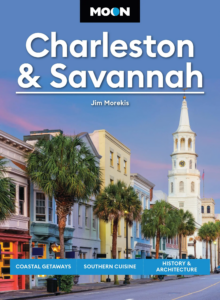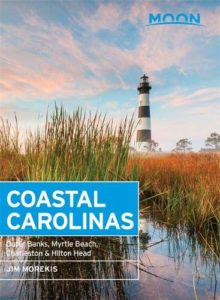Cape Romain to Fort Sumter
Cape Romain National Wildlife Refuge
Dense forests stretch west from the highway, while the unspoiled Cape Romain National Wildlife Refuge stretches south of McClellanville nearly to Charleston, forming one of the largest and most important sanctuaries for migratory birds on the East Coast. Thousands of great blue herons, pelicans, terns, and ducks join the resident population of wild turkeys, feral pigs, deer, and alligators. To get a glimpse of the diverse life protected here, visit the Sewee Visitor and Environmental Education Center (843/928-3368, Wed.-Sat., free), on US-17 at Awendaw. Exhibits inside explain the natural and human history of the region, and trails outside lead to a boardwalk viewing area and an enclosure that’s home to native red wolves.
Directly across from the refuge entrance on US-17, you can appreciate other aspects of the area’s culture at the homey SeeWee Restaurant (4808 N. US-17, 843/928-3609), a general store turned restaurant serving homemade specialties, including a fabulously rich she-crab soup, served with a shot of sherry on the side. The ambience is perfect—tin cans and bottles still fill the shelves, and locals stop by to offer their catches—and the low prices and friendly people make it worth planning your trip around.
Fort Moultrie and Mount Pleasant
Sitting at the entrance to Charleston harbor, across from its better-known sibling, Fort Sumter, Fort Moultrie (daily, $10 adults) overlooks the Atlantic with good views of passing ships and the city of Charleston. The location alone would make Moultrie well worth a visit, but most come because of its vital role in American military history. Originally built from palmetto logs during the Revolutionary War, and since rebuilt many times, the fort is a testament to the development of coastal defenses. Its well-preserved sections date from every major U.S. war between 1812 and World War II, when Fort Moultrie protected Charleston harbor from roving German U-boats. But the fort is most famous for its role in the events of April 1861, when Fort Moultrie touched off the Civil War by leading the bombardment of Fort Sumter.
Fort Moultrie is easy to reach. From Mount Pleasant, a suburban community on the north bank of the Cooper River across from Charleston, turn south from US-17 onto Hwy-703 and then follow signs along Middle Street to the fort. Along with Fort Moultrie, Mount Pleasant itself is worth visiting for the many African sweetgrass basket-makers who set up shop along US-17. While the roadside is rapidly filling up with suburban tract-houses, in the warmer months women sit and weave these intricate baskets at their ramshackle stands. Like so many other Lowcountry traditions, sweetgrass weaving may soon be a lost art, as younger women are increasingly reluctant to take on this low-paid work; it can take four or five hours to weave a basket that may sell for less than $60.
You can also reach Fort Moultrie via the pleasant beach town of Sullivan’s Island, home to two fine food stops, across the street from each other and two blocks from the beach: casual Poe’s Tavern (2210 Middle St., 843/883-0083), where the menu includes fresh fish, beers, and burgers, and Home Team BBQ (2209 Middle St., 843/883-3131), for smoky ribs, moist pulled pork, and sports on TV.
Fort Sumter National Monument
Commanding an island at the mouth of Charleston Harbor, Fort Sumter National Monument marks the site of the first military engagement of the Civil War. On April 12, 1861, a month after Abraham Lincoln’s inauguration and four months after South Carolina had seceded from the United States, Confederate guns bombarded the fort until the federal forces withdrew. The structure was badly damaged, but no one was killed and the fort was held by the Confederates for the next four years, by which time it had been almost completely flattened. Partly restored, but still a powerful symbol of the destruction wrought by the war, Fort Sumter is a key stop on any tour of Civil War sites.
You can visit Fort Sumter by taking your personal boat or by taking a ferry tour boat (843/722-2628, $24); they leave from Patriot’s Point, just off US-17’s soaring cable-stayed bridge across the Cooper River. (Other boats to Fort Sumter dock at the Fort Sumter Visitor Education Center in downtown Charleston.) Patriot’s Point is also the anchorage of the aircraft carrier USS Yorktown (daily, $24), centerpiece of an excellent floating maritime museum that also includes World War II-era fighter planes, a destroyer that took part in D-Day, a River Patrol boat, and a Cold War-era submarine.
Related Travel Map
















